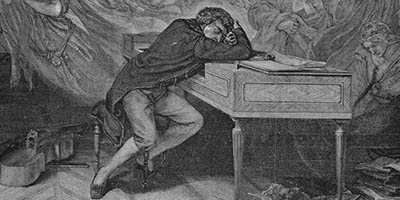The Grosse Fuge (Great Fugue) is Beethoven’s most complex work. It was originally to be the last movement of his String Quartet No. 13. However, it unluckily proved to be both technically challenging for the performers and bewildering to the audience, and was, instead, turned into its own stand-alone work.
Franz Welser-Möst has described how Beethoven creates whole worlds in his pieces, and the Grosse Fuge is no exception: through its complexity, he has conjured a vast cosmos of sound and invited the listener to delve into its mysteries. And yet, true to the promethean ideology undergirding much of his music, Beethoven left the Grosse Fuge open-ended, allowing the listener an opportunity to grapple with its fiery creativity, and to decide for himself or herself what meaning it could hold for them.
The Grosse Fuge is a double fugue on an immense scale. A fugue is a musical form dating back to the Baroque era in which one instrument introduces a theme (referred to as the subject), that will be passed among all of the other instruments. Throughout the piece, the subject returns, sometimes in full; other times, in fragments. In a double fugue, two different subjects are introduced at once, effectively doubling the piece’s information density. In addition, Beethoven has merged the double fugue with any number of other forms — sonata form, a single-movement symphony, or even opera — to create a “metagenre” that subsumes aspects of each form.1 Combined with edgy dissonances and complex rhythms, the Grosse Fuge challenges listeners to stretch their ears and explore its rich sound world — a true promethean endeavor.
 Undated postcard adaption of Rudolf Eichstaedt’s “Beethoven at dawn in his study” (1899). Image courtesy of the Goethezeitportal
Beethoven (arr. Weingartner), Grosse Fuge (for string orchestra)
Undated postcard adaption of Rudolf Eichstaedt’s “Beethoven at dawn in his study” (1899). Image courtesy of the Goethezeitportal
Beethoven (arr. Weingartner), Grosse Fuge (for string orchestra)
The Cleveland Orchestra, Christoph von Dohnányi
Archival Recording: London, Royal Albert Hall, September 5, 1990
1 Daverio, John. “Manner, Tone, and Tendency in Beethoven’s Chamber Music for Strings.” In The Cambridge Companion to Beethoven, edited by Glenn Stanley (New York: Cambridge University Press, 2000), 163.
Alexander Lawler
Alexander Lawler is a Historical Musicology PhD student at Case Western Reserve University. This is his third year working in the Orchestra’s Archives, having previously written “From the Archives” online essays (2015-2016) and designed a photo digitization and metadata project (2016-2017).

The Prometheus Project
As part of the Centennial Season’s celebration, Franz Welser-Möst has created “The Prometheus Festival,” examining Beethoven’s music through the metaphor of Prometheus.
Read more >

Overture to The Creatures of Prometheus
Perhaps the most overt example of Beethoven’s interaction with the idea of Prometheus was his only published ballet, The Creatures of Prometheus.
Read more >

Symphony No. 1
In the mainstream history of Beethoven, his early works are more classical in style, hewing close to Mozart and (especially) Haydn.
Read more >

Symphony No. 7
In the Seventh, Beethoven suffuses each movement with a unique and persistent rhythmic pattern.
Read more >

Overture to Coriolan
Beethoven’s Overture to Coriolan is the only tragic piece in our Prometheus Festival. Indeed, in spite of the intense conflict that marks much of his music, Beethoven was something of an optimist
Read more >

Symphony No. 5
Beethoven’s Fifth Symphony is so familiar to us now that it might be difficult to imagine it as shocking or difficult.
Read more >

Symphony No. 8
The Eighth Symphony generally has been regarded as the slightest of Beethoven’s mature symphonies because of its short length, lighter tone, and frequent return to the musical styles and forms of the eighteenth century.
Read more >

Leonora Overture No. 3
Fidelio (1805), Beethoven’s only opera, is a celebration of freedom. In the opera, Florestan has been imprisoned by the tyrant Don Pizarro.
Read more >

Symphony No. 2
Beethoven first realized he was becoming deaf in the summer of 1798, at age twenty-seven. After an initial episode of total deafness, Beethoven found that his hearing had become filled with an unending “maddening chorus of squealing, buzzing, and humming.”
Read more >

Symphony No. 6
Beethoven’s Pastoral Symphony premiered on the same concert as the Fifth Symphony (December 22, 1808). The two works were quite different: Whereas the Fifth was a difficult journey from darkness to light, the Pastoral was a genial, warm-hearted journey through the countryside.
Read more >

Grosse Fuge
The Grosse Fuge (Great Fugue) is Beethoven’s most complex work. It was originally to be the last movement of his String Quartet No. 13. However, it unluckily proved to be both technically challenging for the performers and bewildering to the audience, and was, instead, turned into its own stand-alone work.
Read more >

Symphony No. 9
Beethoven’s Ninth Symphony stands as the culmination of Beethoven’s twenty-four-year career as a composer of symphonies. The Ninth both sums up Beethoven’s artistic career and, with the choral finale, daringly points the way forward to new conceptions of what a symphony could say and be.
Read more >